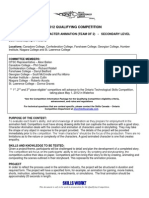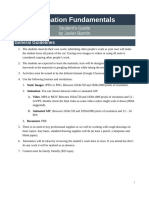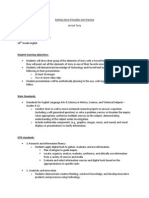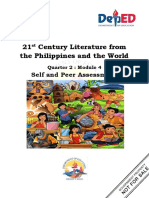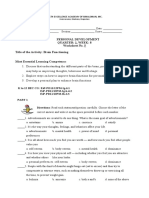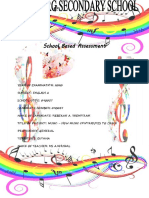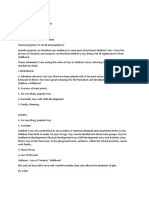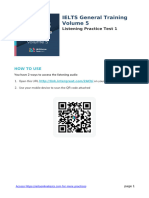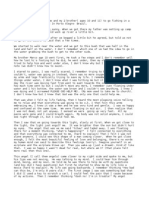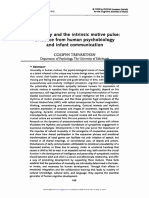STUDY GUIDE
1
� STUDY GUIDE
SHUTTER ISLAND
VISUAL STORYTELLING + PHOTOGRAPHY
The theme of this round revolves around the art of visual
storytelling using a series of photographs. This involves
creating a link between the photos to ensure coherence and
consistency, making them flow seamlessly and evoke
emotions.
In this round, you will be tested in various aspects. For
example:
Plot: The elements of the plot should be well thought-out.
It is advised to keep the plot less complex to avoid
weakening the links between the elements of the plot.
Quality of Pictures: Various aspects of the individual
photos such as exposure, composition, and colors will be
judged.
Consistency of Progression: The contribution of each
image to the buildup of the story and to each of the plot
elements.
Uniformity in Pace: The story shouldn’t be too dragged or
too fast.
It is advised that you go through the following material before
the event:
1. https://www.adobe.com/creativecloud/photography/discover/photo-
composition.html
2. https://prowritingaid.com/story-elements
3. https://www.ourkindred.co.uk/theblog/visualstorytelling
4. https://www.c-and-a.com/eu/en/shop/photo-editing
5. https://capturetheatlas.com/photography-basics/#exposure
2
� STUDY GUIDE
COSMIC CUTS
SCI-FI & BIOPIC FILMMAKING
This round draws inspiration from two of Nolan’s blockbuster
hits: Inception and Oppenheimer. Teams can choose to either
create a 3-5 minute movie trailer based on their own
exaggerated concept of science and physics (similar to
Inception's focus on angular momentum and warped
timelines) or direct a captivating short film that documents the
life of an influential figure in science, math, or physics, much
like Nolan’s portrayal of Oppenheimer.
You will be tested on 3 key metrics:
1. Video Editing & Production: We recommend using tools
like Premiere Pro, After Effects, or Final Cut Pro. Other
software like Filmora or iMovie can also be used if needed.
The final product should include transitions, effects, music,
color grading, and other editing techniques commonly
used in sci-fi and drama productions. Therefore, delegates
should be familiar with the aforementioned editing
techniques, tools, and software to ensure a polished final
product across various platforms.
2. Script Quality and Attention to Detail: In addition to post-
production metrics, the round also places an emphasis on
scientific accuracy. Trailers should showcase an
exaggerated physics concept and its impact on the
characters' world, while biopics should provide a detailed,
dramatized account of the figure’s life and contributions.
Consistency in theme, character roles, and details—such as
maintaining a coherent concept (e.g., gravity or
wormholes) or reflecting the historical era through
3
� STUDY GUIDE
language, setting, and costumes—will also be evaluated.
3. Camerawork: While film quality isn’t the main focus, it
should still do justice to the idea of stepping into Nolan’s
shoes. Though submissions aren’t expected to match
the cinematography of Inception or Oppenheimer, blurry
footage or hard-to-follow visuals will be penalized.
The following links and resources will help you prepare for the
round. We also recommend consulting additional materials
based on your submission's requirements (effects, software,
etc.).
https://youtu.be/keoszhf4DZ8?si=Iag1VIPXbiHnFggN
https://www.youtube.com/watch?v=vuuogK-Iymo (blatant
copy of inception is prohibited, must be your own idea)
https://youtu.be/OGf2BqcBJAo?si=ZMxW3eL6e0o3kk3i
https://youtu.be/7bWdJX4dnew?si=S-CNlFsghjvxu10V
https://youtube.com/playlist?list=PLW-zSkCnZ-
gDRQxW05I3nhwE6F25Lr98Q&si=6id00wFZ-z_h1jQx
https://youtu.be/cmPBJLfnjJk?si=gTCOG2k_5Fq6PrFZ
https://youtu.be/RvFCnVRcT3Q?si=tD8LUws_gm8_y5ut
https://boords.com/blog/how-to-write-a-short-film
4
� STUDY GUIDE
BEYOND THE PIXELVERSE
SCRATCH BASED GAME DEV & ANIMATION
In the final round, participants will be tasked with expressing
their creativity and ingenuity in the world of scratch.
Combining the worlds of art and programming, delegates will
have to create a short animation or game incorporating the
campus of LUMS. Campus landmarks, the university map and
anything else within the bounds of the university can be
incorporated within the round.
Task:
Participants will be required to:
Create either a game or an animation.
The animation should be 2 to 4 minutes long.
Focus Areas:
Creativity: Innovative ideas and unique implementation of
the LUMS campus within the animation/game.
Quality: How well the idea is implemented, quality of
animation, compelling storylines and a focus on creating
enjoyable and engaging animations/games.
Functionality: The game or animation should be smooth
and free from significant bugs.
Critical Thinking: The project should demonstrate problem-
solving skills and clear thought processes in design and
implementation.
5
� STUDY GUIDE
Prior Knowledge:
Familiarity with the basics of Scratch which include:
Basic programming logic( sequencing, loops, conditionals,
variables)
Navigating the scratch interface
How to create and incorporate sprites, blocks, backdrops,
costumes and sound within your project
Helpful resources:
Beginner guide on scratch:
https://www.youtube.com/watch?v=D-nW4jvzRr8
Scratch animation:
https://youtu.be/uv8mbL-MC58?si=xKp6Z2jdm7GNiB9q
https://youtu.be/Ngy_J4Fn2oI?si=uA8aL43JXUNzpnRe
The following is a playlist for how to code several game ideas
within scratch. While you do not need to go through all of
them, you should get a better idea of the thinking process that
goes into coding a scratch game.
https://www.youtube.com/playlist?
list=PLy4zsTUHwGJJooiDHnqXSeHvKHIrXiAHS
NOTE:
Resource material and details/grading criteria for each round
could be subject to change. In such an event, delegates will be
notified aptly but the key themes of visual storytelling, film-
making, and programming-based animation will almost
certainly be retained in the event.



























